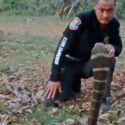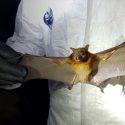In 1986, 25-year-old Rodney Chayko and his friend David Sager rode in the last seats of the Mindbender, the world’s tallest indoor roller coaster. They were excited and looking for a night of fun. As soon as the coaster started moving, Rodney felt the car sway over the railing. But it was too late to stop the ride. Within seconds, they were moving at a speed of 100 km/h (60 mph) and then everything went black.
The last car of the coaster had struck a pillar and thrown everyone inside to the ground. All of the passengers were dead, except for Rodney. Was he just lucky? Or was it a last-minute decision that saved his life?
Roller coasters originated in Europe in the 19th century. Early thrill-seekers used to ride them at about 80 km/h (50 mph). Modern roller coasters move on the same principle of gravity. But these modern machines can speed along at up to 240 km/h (150 mph) and free-fall from a height of 140 m (460 ft). Can you imagine being thrown off one of these machines? Unfortunately, some people have been, and a few have survived.
Today we’ve compiled the top three most incredible stories of these survivors. Pay attention because you might learn something that could save your life one day.
How quickly can you stop a roller coaster in an emergency? How can you tell if something is wrong before the ride starts? And what can you do to survive such a fall?
But before we dive into these terrifying accidents, let’s see how safe you are right now. Yes, you, at home, watching this video on your phone or computer, may be surrounded by threats. But don’t worry. As always, we have just the solution you need.
Number 3: The Dangling Child
May 30, 2019. It was a normal day during spring break at the Lightwater Valley theme park in Yorkshire, UK, when a mother and her 6-year-old son boarded one of the park’s roller coaster cars. The passengers were attached to the carriage by a safety bar. Some people recalled seeing that the child didn’t appear to be safe behind the lap bar.
Then the ride began. A few seconds later, the child slid out of his seat. His mother started screaming for help. Other park visitors saw the little boy dangling outside the ride, and they alerted the ride operator because he hadn’t noticed the emergency. The operator activated the brakes, but it took about 10 to 12 seconds for the car to stop. The child let go and fell 5 m (15 ft) to the ground. The child was transported to a nearby hospital for treatment, and luckily he only had non-life-threatening injuries.
Investigators discovered that the park operators breached safety regulations by failing to inform the child and his mother that he should be wearing a seatbelt, as the restraining bar was not enough to keep him safe. Fortunately, the child survived, and the park was fined over $480,000. Yes, that’s how failure to comply with safety laws can make a safe ride deadly.
Number 2: The Mindbender
Remember Rod and his friend David? They were thrown out of a roller coaster car in Edmonton, Canada, in 1986, along with two other passengers. Sadly, David, 24, Tony, also 24, and Cindy, 21, died in the accident. But Rod survived. He recalls that, as the ride started, he felt the car rocking on the rail, so he held on tightly to the handle. That might have saved his life, because a few seconds later, the car was going 100 km/h (60 mph) when, as some reports say, it hit a pillar and derailed.
The four youngsters were thrown from the carriage and fell to the ground. Rod’s legs and back were crushed and broken. Doctors even considered amputating his legs but decided to put in some plates. Amazingly, after six months in hospital, Rod healed. He’s a grandfather now but suffers from chronic back pain and he says he has remembered David, Tony, and Cindy every day of his life for more than 30 years.
But before we move on to our final story, let’s look at what was behind these horrific accidents. The Mindbender had been serviced and checked the same day of Rod’s accident. When he got into the car, though, something didn’t seem right. It was swaying, rocking on the rail.
But no one said anything. Also, as the Lightwater Valley theme park ride was about to begin, some passengers recall feeling some concern for the 6-year-old’s safety. He was riding loose behind the safety bar, not wearing a seatbelt. So, remember, it’s crucial that you speak up if something doesn’t seem right, or you have any safety concerns. Your warning can save someone’s life, even yours.
Number 1: The pinball fall
Unlike these last two incidents, when Amanda Bostic rode a Daytona Beach roller coaster in 2018, everything seemed to go smoothly. Her seatbelt clicked into place, and a park operator checked it. But she remembers that the car was going faster than she was comfortable with.
At the first curve, she felt the car was not fully attached to the rail. She began to hear metallic screeching and people screaming. She held on to the handle and prayed for it to end. But seconds later, the carriage derailed and she got thrown into the air. Other passengers saw her bounce around the structure from pillar to pillar like a pinball. Finally, she hit the ground. She suffered bruises and cuts all over her body, a concussion and broken teeth. But she survived.
Investigators discovered that the authorities had pointed out safety problems, such as excessive corrosion, two years before the accident. Although those complaints did get addressed, Amanda insists that “”something must have gone wrong,”” as she ended up in a terrible accident that nearly cost her her life. That’s why conscientious maintenance and constant servicing are required to avoid roller coaster accidents.
Unfortunately, roller coasters aren’t the only amusement rides that can kill you. Have you ever gone down a waterslide? It was fun, wasn’t it? But if you weren’t careful, you could have lost your head. It happened once on one of the largest waterslides in the world.
Sources
- “Roller Coaster Passenger Who Survived 34-Foot Fall Was ‘Praying It Was Over‘”. ABC News.News, ABC. 2021.
- “‘It Changed My Life Forever:’ Survivor Of 1986 Mall Coaster Crash Wants Memorial | CBC News“. 2021. CBC.
- “Boy Plummets 30 Feet From Roller Coaster At Theme Park“. 2021. Nypost.Com.
- “Lightwater Valley Fined £350K Over Boy’s Rollercoaster Fall“. 2020. BBC News.
- “Mindbender“. 2021. Bestedmontonmall.Com.
- “Authorities Today Investigated A Weekend Triple-Loop ‘Mindbender’ Roller Coaster…“. 2021. UPI.



























